Divorce
Realized he was Jesus
Here at WU we've explored a number of odd reasons marriages have failed (such as the husband's over-fondness of horse fondling, and a man's dislike of his wife's deformed nipples).Add to this list Alan John Miller, whose marriage didn't survive his realization that he was Jesus Christ, reincarnated. I can see how that might put a strain on a relationship.
Miller (aka Jesus) went on to found the Divine Truth ministry in Australia. He still claims to have been Jesus and says that he remembers many details of his past life, such as his crucifixion (says it wasn't that bad). However, he doesn't remember how to speak Aramaic.
He's also found a new life partner, Mary Luck, who coincidentally happens to be Mary Magdalene, reincarnated.
More info: Times Live

Mary Luck and Alan Miller (aka Mary Magdalene and Jesus)
Posted By: Alex - Thu Sep 17, 2015 -
Comments (14)
Category: Religion, Divorce
Fondles horse, but not his wife
I'm guessing the copy editor had fun coming up with this headline...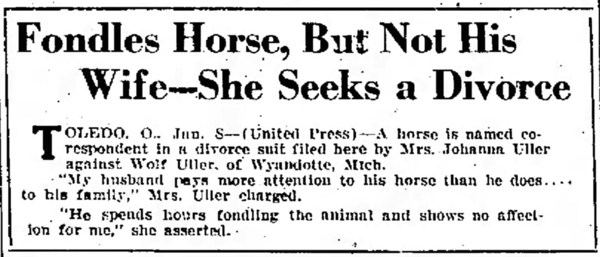
Portsmouth Daily Times - Jan 8, 1926
TOLEDO, O. Jan. 8—(United Press)—A horse is named co-respondent in a divorce suit filed here by Mrs. Johanna Uller against Wolf Uller of Wyandotte, Mich.
"My husband pays more attention to his horse than he does... to his family," Mrs. Uller charged.
"He spends hours fondling the animal and shows no affection for me," she asserted.
Posted By: Alex - Tue Sep 15, 2015 -
Comments (6)
Category: Divorce, 1920s
The Case of the Allergic Bride
Joyce and Nolan Holdridge married in San Francisco on March 3, 1947. He was a watchmaker, recently out of the Navy. She was a telephone operator.At first their marriage was a happy one, but a few months after their wedding Joyce began to grow sick. Her eyes reddened and swelled shut. She broke out in an irritating skin rash that covered her from head to toe.
Joyce sought help from doctors, psychiatrists, and skin specialists, but in vain. Eventually her condition grew so bad that she was hospitalized at the Veterans Administration Hospital in San Francisco. And it was here, while she was under constant observation, that the doctors noticed an unusual pattern to Joyce's outbreaks.
While she was at the hospital, her symptoms gradually subsided, but when she visited her husband each weekend they promptly flared up again. Soon the doctors arrived at a startling conclusion. Joyce appeared to be allergic to her husband.
Separation The Only Option
Further observation made it clear that Joyce wasn't reacting to a cologne her husband was wearing, or some other chemical irritant that could easily be removed. She appeared to be allergic to the man himself. His mere presence. In fact, even mentioning her husband's name caused Joyce to break out in hives.
The doctors diagnosed Joyce's allergy as neurodermatitis, and counseled her that all attempts at a cure would be futile as long as she was living with her husband.
So in March 1948, a year after getting married, Joyce and Nolan began living apart. He stayed in San Francisco and she moved to Los Angeles. This cured Joyce's rash, but eventually the couple decided that living separate lives, while still married, didn't make sense. So in July 1949, Joyce filed for divorce from Nolan.
Divorce Trial
The divorce trial was held in the Los Angeles Superior Court of Judge Ray Brockmann on July 25, 1949. Nolan didn't attend, as he wasn't disputing the facts.
Joyce told the judge that she had no complaint about her husband's behavior. In fact, he was "the finest husband a woman could ask for" and she loved him deeply, but every time they were together she broke out in a rash from head to toe. So at the advice of physicians and psychiatrists, she had to leave him.
To back up this claim she produced a medical report from Dr. Gordon Dayton of the San Francisco Veterans Hospital who wrote, "[Joyce] had been suffering from a severe generalized dermatitis manifested by reddened, swollen, itching and scaling areas most marked over the hands, forearms, chest, neck, face and thighs. It soon became evident that there was something physical in the home or about the person of her husband to which she was sensitive."
\Determining Fault
Judge Brockmann listened with sympathy to Joyce's presentation of her case. However, there was a problem. In order to grant a divorce, it had to be shown that one of the spouses was at fault, and it wasn't clear that anyone's behavior was to blame in this case.
It used to be a standard requirement in American law that a couple could only get divorced if one of the spouses was at "fault" for causing the breakdown of the marriage. Actions that constituted fault included adultery, abandonment, or cruelty.
Divorce-seekers would regularly stretch facts in order to argue that their spouse was somehow to blame for ruining the marriage. For instance, one man complained that the snores of his wife's dog had made it impossible to sleep in the same room with her. In another case, a wife charged that her husband would cruelly shut off his hearing aid so that he couldn't hear her side of arguments. Similar strange marital complaints were a regular feature in weird news columns of the time.
It was only in 1970 that California made "no-fault" divorces legal, allowing couples to separate simply because they wanted to. All other states eventually followed suit.
But in 1949, demonstrating fault was still the legal requirement to obtain a divorce, and Judge Brockmann didn't think that an allergic reaction was anyone's fault. So he pressed Joyce for details, trying to determine if Nolan was ever cruel to her.
Joyce suggested the allergy was cruelty, but the judge disagreed, and with that he denied her request, ruling that being allergic to your spouse was not grounds for divorce.
Controversy
Joyce's case caused a popular sensation. Headlines trumpeted the case of the "allergic bride." One widely reprinted photo showed Joyce holding her pet dog "Taffy." The caption noted that although she was allergic to her husband, the dog didn't seem to bother her in the least.
Newspapers generally treated the case as yet another example of the "silly" reasons that people got divorced. However, Joyce's effort to obtain a divorce received a flood of popular support, particularly from women. Judge Brockmann reported receiving hundreds of letters, mostly from wives, urging him to reconsider his ruling. A number of these letter writers claimed that, like Joyce, they were allergic to their husbands. Wrote one woman, "This is a real cause for divorce. It is a cause made by nature — not by man."
Resolution
Thankfully Joyce and Nolan were not doomed to remain married forever. Judge Brockmann suggested that there was another legal option available to end their marriage — annulment. Unlike a divorce, an annulment could be granted on the basis of "physical incompatability." There was no need to determine fault.
So in September Nolan filed suit, asking that his marriage be dissolved since Joyce could not perform her "wifely duties." Judge Brockmann again heard the case, but this time he promptly granted an annulment, allowing Joyce and Nolan to go their separate ways. Some years later Nolan remarried, and there was no report that his new wife developed any allergic reaction to him. What became of Joyce is not known.
Postscript
Joyce and Nolan's case was seen as being a first of its kind, setting a legal precedent. But Judge Brockmann warned others not to try to get out of marriage on "allergy grounds" unless they could produce valid medical evidence that would withstand a "scrutinizing judicial eye."
Inevitably his advice was ignored, and throughout the 1950s a number of wives (Rose Savenick of Los Angeles, Zelam Ansley of Seattle, Virginia Miller of Beverly Hills, etc.) filed for divorce on the grounds that they were allergic to their husbands. All won their cases, perhaps because of the precedent set by Joyce and Nolan. Eventually the adoption of "no-fault" divorce laws made it unnecessary for women to plead allergies to get out of a marriage.
But what about the men? Was spousal allergy a problem that only affected wives? In fact, the media did report about a few husbands who were allergic to their wives, but for whatever reason these husbands didn't seek divorces. For instance, in 1962 Dr. Michael O'Donnell wrote in the British medical magazine Family Doctor about a man who had developed asthma because he was allergic to his wife. However, "It was not until the death of the wife—a formidable and overpowering lady—that the doctors made their discovery," wrote the physician. Because on the day of her death, the man's asthma attacks stopped. "He has never had an attack since," observed O'Donnell.
Posted By: Alex - Wed Sep 09, 2015 -
Comments (15)
Category: Health, Wives, Divorce
Garlic Toast Divorce
Some people take their garlic toast very seriously.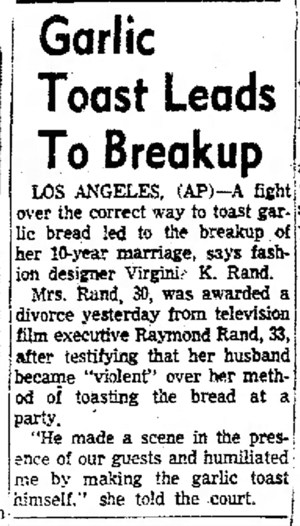
Corpus Christi Times - Jan 15, 1957
Posted By: Alex - Sat Aug 01, 2015 -
Comments (5)
Category: Divorce, 1950s
Wife plugged in to alarm clock
Sounds to me like Anna Hindman had good cause for wanting to divorce her husband, namely a) his belief that 4 hours sleep is all anyone needs, and b) wiring her bed to shock her every 4 hours to prevent her from sleeping longer than that.But according to the news reports, she eventually forgave him and withdrew her divorce petition — after he got rid of the "shocking machine." And it sounds like they remained married for the rest of their lives... if the Anna Hindman in this obituary is the same person (which it must be, because all the names/dates match up).


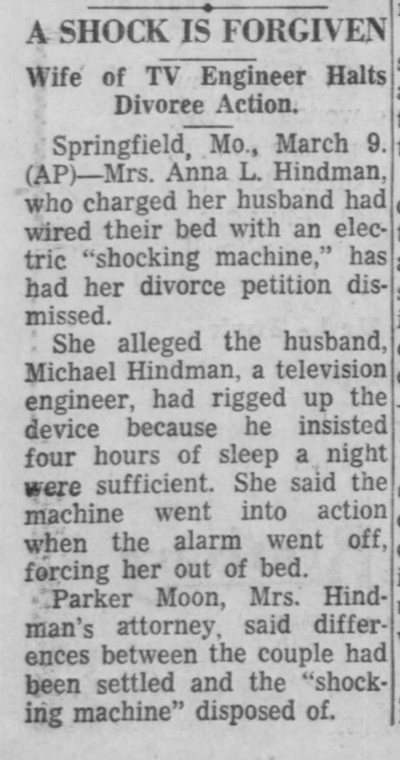
Sources: Kansas City Times: Feb 27, 1960; Mar 10, 1960.
Posted By: Alex - Fri Jul 10, 2015 -
Comments (5)
Category: Husbands, Wives, Divorce, Marriage, 1960s
Deformed nipples as grounds for divorce
An Australian man has explained that when he discovered his wife had "deformed" nipples — which he only discovered two years after they got married in 1972 because it took that long before he saw her undressed — that was when he knew he wanted out of the marriage, but he stayed with her out of a sense of duty, and they proceeded to have 3 children together before finally separating in 2011. But for the sake of deciding how to divide up joint assets, he feels the marriage should be considered to have ended in 1974, at the moment of the nipple disfigurement discovery. The judge, however, didn't buy the argument. [stuff.co.nz]
Posted By: Alex - Mon Apr 13, 2015 -
Comments (6)
Category: Husbands, Wives, Divorce, Marriage
Husband For Sale
1935: Mary Ann and Fred Cordes weren't doing too well with their marriage. But instead of just getting a divorce, like normal people, they (well, it was mostly Mary Ann's idea) hatched a plan to sell Fred for $1500 to any woman willing to buy him. Mary Ann hoped to use the money to travel to Ireland, her childhood home.I don't know how their plan turned out. It's one of those stories that never got a follow-up in the press. But I can't imagine women were lining up to pay $1500 to acquire "all the rights" to a 40-year-old unemployed ice-cream maker.
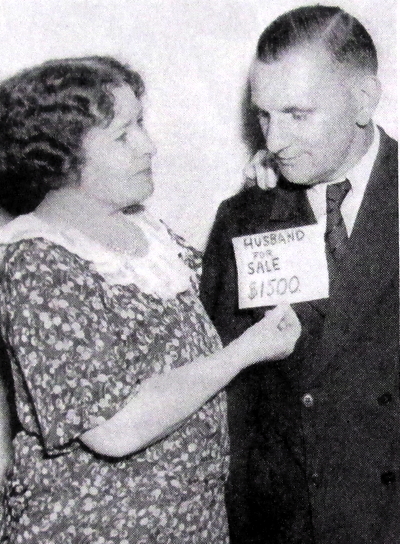
Time - Aug 26, 1935
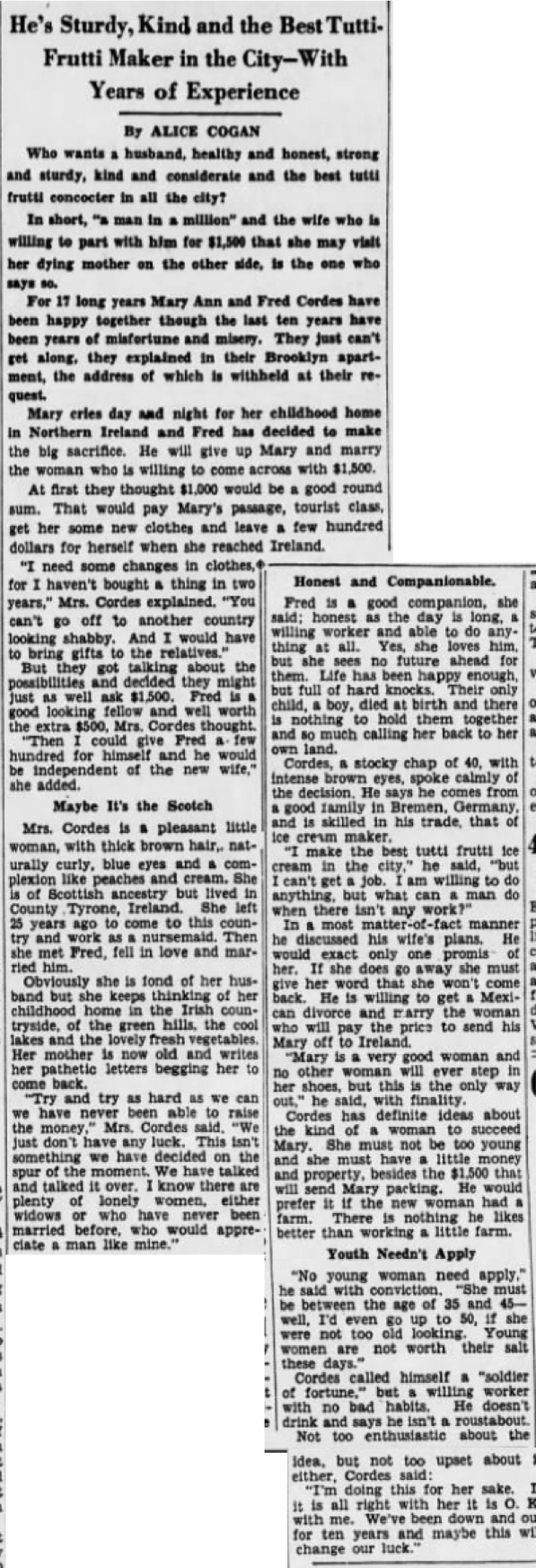
The Brooklyn Daily Eagle - Aug 14, 1935
Posted By: Alex - Wed Aug 06, 2014 -
Comments (14)
Category: Divorce, Marriage, 1930s
Trust Issues
Married for 30 years, this poor woman became a widow in February 2011. But wait, did I say widow? Not so much, as her husband secretly divorced her 8 years before. Then he continued to live with her as always but upon his death she was left with nothing. The man's grown children from a previous marriage are fighting her for everything. I guess we women will have to start checking the county records periodically if it is that easy to divorce someone without their knowlege. What a dirty rotten trick.
Posted By: Alex - Fri Dec 14, 2012 -
Comments (12)
Category: Divorce
Weird Science - I Sing The Body Eccentric

Social pressure also crops up in explaining another finding this week, this one by Meridith Young of McMaster University in Ontario, that what single women eat depends a lot on whom they are eating with. After covertly monitoring the canteen behaviour of 470 undergraduates, Young found that women significantly lowered their calorie intake when sat with men compared with all women groups. Moreover, the more men a woman sat with, the less on average she consumed. In the journal Appetite, she puts the discrepancy down to women unconsciously advertising themselves to men, adding "the salad leaves are meant to say, I'm pretty, I'm attractive, I take care of myself" (Guardian).
Of course, we all know what men really like in a woman; that she not appear too powerful. Or so says a study by Brian Meier and Sarah Dionne of Gettysburg College in Pennsylvania. In the study, eighty 19 year-olds were asked to rate the attractiveness of a number of images presented in random order, some of which would be repeated. In fact the subjects saw each image twice, once near the top of the screen and once low down. The researchers found that men rated women 1.8% more attractive when observed near the bottom, and women found men 1.5% better looking when higher up. They suggest that their findings might explain why men are taller than their women partners more frequently than would be expected by chance (Times of India).
As to what women really like in men, perhaps not being British should be somewhere on the list. After champagne controversially lost out to an English wine earlier this week, French scientists have hit back at British research that concluded that the mythical “G-spot” did not exist. “Of course it exists,” say French gynaecologists, “you just can’t find it!” The original study by King’s College in London looked at over 900 pairs of identical or non-identical twins in the expectation that the identical siblings should both report having a G-spot more frequently than the others, they did not. The French however claim their cross-channel colleagues have got the wrong end of the speculum, “It is not a question of genetics but of use," said one (Telegraph).
More in extended >>
Posted By: Dumbfounded - Wed Feb 03, 2010 -
Comments (6)
Category: Babies, Cosmetics, Exercise and Fitness, Politics, Science, Anthropology, Experiments, Psychology, Sexuality, Divorce, Obesity
Weird Divorce

Next is the case of the divorce granted to the Chinese couple who had not seen each other since their wedding, three years previously. The ceremony took place in China’s Machong district and was the result of an arranged marriage by the parents of the couple, called Ma and Mo, who were good friends. But Ma, the groom, left for a job elsewhere straight after and the newlyweds did not even try to stay in touch. With no children or property to argue over, the divorce went fairly uneventfully (China Daily).
Staying in China for a moment, Shoutsee Li and Han Fucheng of that country’s Mentougou district are hoping a judge will annul their marriage so they can marry again, this time legally. The couple originally married in 2006 after meeting nine years earlier, but Li was in China under false papers and now faces deportation. But while the police don’t recognise Han and Li’s marriage, the registrar does, and will not let them remarry until their current marriage is dissolved (People’s Daily).
Not so likely to remarry are recently separated couple Robin Williams and Anthony Hull of Kingsfold in England. Attempts to reach an agreement on how to divide their £500,000 ($850k) house have stalled amid arguments over who keeps the cheese grater and whether paint pots are communal property. The couple have now taken their grievances to Britain’s High Court (Daily Express).
Also in court this week was Stanley G. Hilton of Hillsborough, CA who is suing San Francisco, its airport, every airline that uses it, and the manufacturers of the airplanes landing there for $15 million each for ruining his marriage. All in all Hilton, a former attorney (now disbarred), cites 37 parties as contributing to the breakdown of relations with his wife, which amounts to a cool $555 million in the unlikely event that he wins (Wired).
More in extended >>
Posted By: Dumbfounded - Mon Nov 23, 2009 -
Comments (3)
Category: Business, Advertising, Eccentrics, Frauds, Cons and Scams, Government, Regulations, Religion, Lawsuits, Divorce

| Who We Are |
|---|
| Alex Boese Alex is the creator and curator of the Museum of Hoaxes. He's also the author of various weird, non-fiction, science-themed books such as Elephants on Acid and Psychedelic Apes. Paul Di Filippo Paul has been paid to put weird ideas into fictional form for over thirty years, in his career as a noted science fiction writer. He has recently begun blogging on many curious topics with three fellow writers at The Inferior 4+1. Contact Us |





